Bulletin – June 2021 Payments Review of the NGB Upgrade Program
- Download 1.46MB

Abstract
A key responsibility of the Reserve Bank is to maintain public confidence in Australia's banknotes as a secure method of payment and store of wealth. To help achieve this objective the Bank initiated the Next Generation Banknote (NGB) program, which involved the design and development of a new banknote series to make Australia's banknotes more secure from counterfeiting. The decade-long program concluded in late 2020, with the release of the final upgraded banknote into general circulation. The program delivered a suite of new Australian banknotes with a range of new innovative security features. Overall the banknotes have been well received by the general public and counterfeiting rates have remained low.
Introduction
Australia has a tradition of developing and introducing technologically advanced security features for banknotes. Most notably, Australia was the first country in the world to successfully use polymer as the production material (or substrate) for an entire series of banknotes. The use of polymer created substantially more secure banknotes, which were much harder for counterfeiters to replicate convincingly than was the case for paper banknotes. However, after nearly 25 years, the security of Australia's banknotes needed to be upgraded and so the Reserve Bank undertook the NGB program.
Overview of the NGB program
While the use of polymer helped ensure that Australia's counterfeiting rates remained low, by the mid 2000s an increasing availability of fairly high-quality reproduction technology began to make Australia's first series of polymer banknotes more vulnerable to counterfeiting. (See ‘Box A: Australia's Counterfeiting Landscape’ for more information on counterfeiting trends). In response to the increasing threat from counterfeiting, the Reserve Bank established the NGB program. The purpose of the program was to upgrade the security of Australia's banknotes to ensure that they continued to be secure against counterfeiting.
The NGB program was publicly announced in 2012 and involved upgrading the entire series of Australian banknotes. The program involved developing banknote designs with new security features, which required a considerable amount of work.[1] For instance, the Reserve Bank considered the security benefits and function of more than 200 security features before deciding on the new features that would be included on the upgraded banknote series. The NGB program also involved extensive consultation with stakeholders – including members of the cash handling industry, the vision-impaired community and the public more generally – to ensure that the new banknotes would continue to meet community needs.[2] The program concluded in October 2020 when the $100 banknote – the final denomination to be redesigned as part of the NGB program – entered general circulation.
Key results of the NGB program
The NGB program was a highly complex, long-running and ultimately very successful project. Of particular note, the program delivered an upgraded polymer banknote series that retains many of the key design elements of the first polymer banknote series – including the colour, size and people portrayed – but also has a range of innovative new security features (Figure 1).[3] As a result, the upgraded banknote series is significantly more secure from counterfeiting than the first polymer series. While it will be some time before a comprehensive assessment can be made on the impact of the new banknotes on counterfeiting activity, at this stage counterfeiting rates have remained low, with negligible counterfeiting of the new polymer series. The upgraded banknote series also has a new feature to assist people with vision impairment, which has improved the accessibility of Australia's banknotes. Finally, and perhaps most importantly, the majority of people have now used a new banknote and the new banknote series has generally been very well received by the public. The key outcomes of the NGB program are discussed in more detail below.
| First polymer series | Second polymer series |
|---|---|
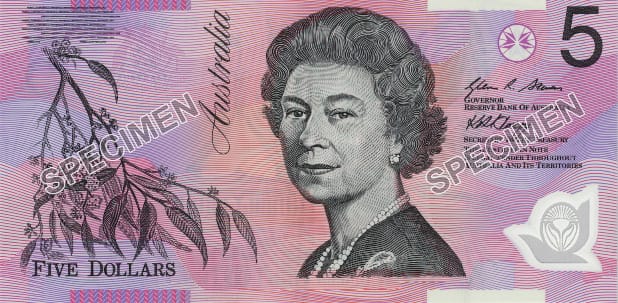 |
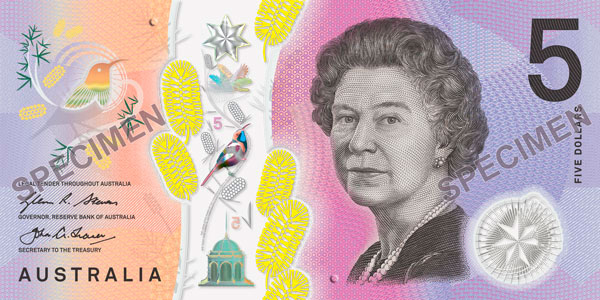 |
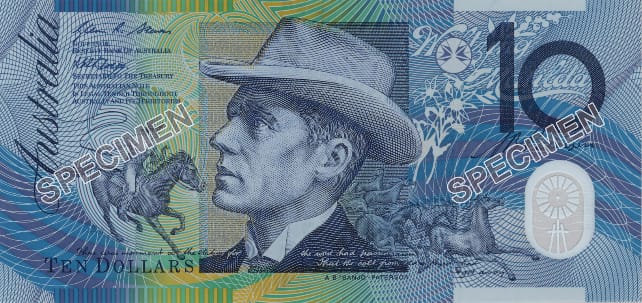 |
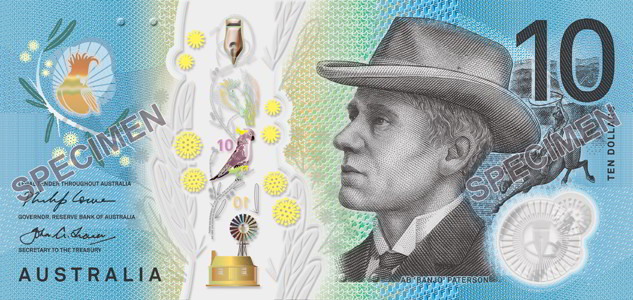 |
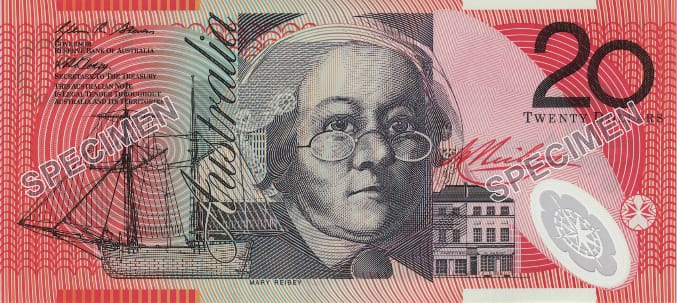 |
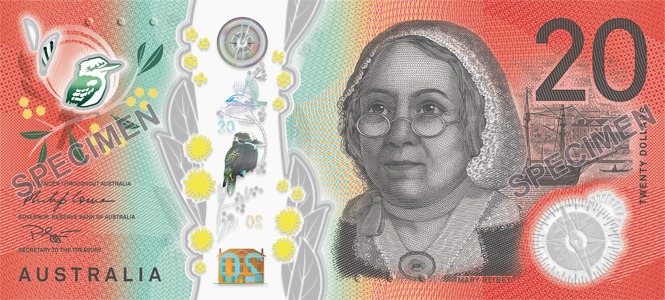 |
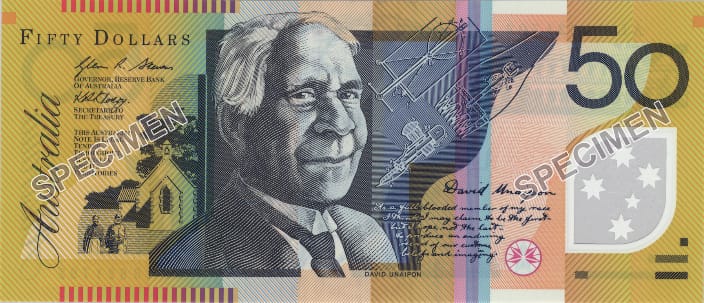 |
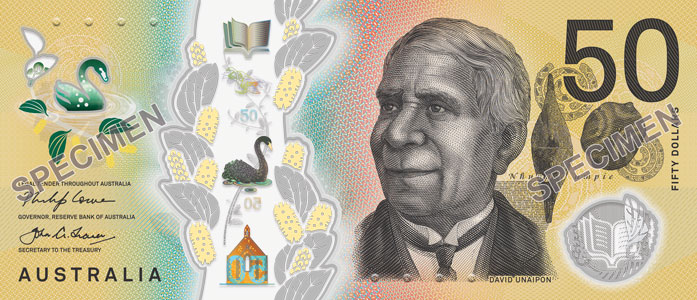 |
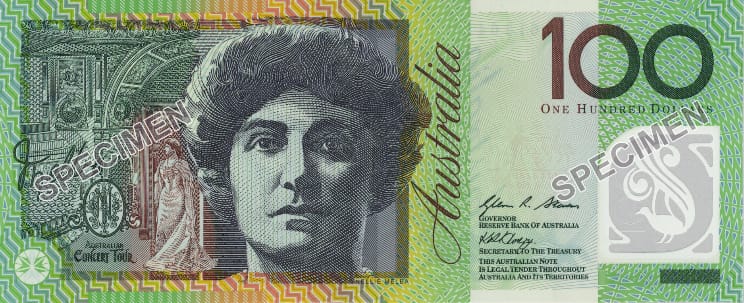 |
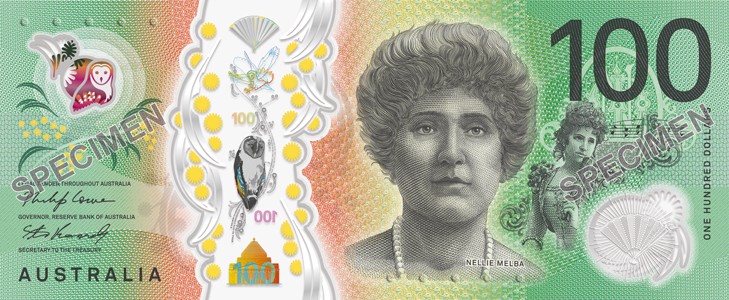 |
Security
The use of new and upgraded security features on the second polymer banknote series ensures that the new banknotes are more secure and, as a result, more difficult to counterfeit than the first polymer series. In particular, the second polymer banknote series includes a range of new dynamic security elements that are not present on the first polymer series. For example, the second polymer series includes a holographic flying bird and reversing number in the top-to-bottom clear window. The upgraded banknotes also have a rolling colour effect; on one side of the banknote it is in a prominent patch near the top corner and on the other side it is within a bird shape.
The second polymer banknote series also includes more secure versions of features that are present on the first polymer series. For example, microtext now features not only in the background of the banknotes but also in the top-to-bottom clear window. All the windows have more intricate designs compared to the first polymer series and there are more elements that fluoresce under ultraviolet light on the second polymer series.
The second polymer banknote series also retains some of the key security features that are used in the first polymer series and are iconic to Australian banknotes. Both banknote series are printed on polymer and use intaglio ink, which has a distinct texture that can be felt by running a finger across the portraits and numerals on both banknote series.
Counterfeiting
Counterfeiting rates in Australia have fallen since 2016, after peaking in 2015. While this aligns with the introduction of the first upgraded banknote into general circulation (the $5 banknote), there is a range of other factors that also contributed to the decline in counterfeiting. (See Box A for a detailed overview of Australia's counterfeiting landscape). Nevertheless, counterfeiting rates continue to decline and remain well below their peak rates. This is expected to remain the case in the near future as the second polymer series becomes increasingly common in circulation. Overall, at this stage, it appears that the NGB program has contributed to a decrease in counterfeiting, although it will be some time before a more comprehensive assessment can be made.
Accessibility
The introduction of a new tactile feature on the second polymer banknote series has improved the accessibility of Australia's banknotes. In particular, following extensive research by the Bank into whether an effective and durable tactile marking could be included on Australian banknotes – which included consultation with the vision-impaired community, other stakeholders and overseas central banks – a decision was made to add raised bumps on each of the long edges of the upgraded banknotes. This new feature joins existing features that help the vision impaired tell the difference between different denominations of Australian banknotes. These include: bright colours; large and bold numbers; and different sizes for each denomination of banknote.
Saturation
Unsurprisingly, since the issuance of the first upgraded banknotes in 2016, new banknotes have accounted for an increasing share of the total number of banknotes in circulation. In other words, the saturation rate has steadily risen.[4] The saturation rate is an important metric as it indicates how common the new banknotes are in the economy. A higher saturation rate means old banknotes series are less prevalent, which helps to prevent counterfeiting as it is more difficult to pass counterfeits of banknotes that are less common.
The new $5 and $10 banknotes are already more common than previous banknote series, as both have saturations rates above 60 per cent. This partly reflects the fact that these 2 denominations were the first to be issued into general circulation (in 2016 and 2017 respectively). However, even allowing for the differences in issuance dates, the higher denomination banknotes ($50 and $100 banknotes) have not replaced the first polymer series as quickly as the lower denominations ($5 and $10 banknotes) (Graph 1). This partly reflects the different ways that high and low denomination banknotes are used. The lower denomination banknotes are more commonly used for transactions than higher denomination notes and so tend to circulate through the economy faster. This means they also wear faster and must be replaced more often. In comparison, the higher denomination banknotes are also used as a store of wealth and so tend to circulate more slowly through the economy. In addition, the $50 banknote is the most common banknote in circulation by both volume and value, accounting for half of all banknotes in circulation. Logistically, this means it will take longer for the existing stock of $50 banknotes in the economy to be replaced compared to other banknote denominations. This slow rate of replacement of high denomination notes is one of the reasons why any decision to upgrade a banknote series should be taken in a forward-looking, pre-emptive fashion.

While the old polymer banknote series still accounts for the majority of all banknotes in circulation, most Australians have now received at least one new banknote. Indeed, a survey commissioned by the Reserve Bank in October 2020 – the RBA Online Banknotes Survey – found that 85 per cent of participants had received at least one of the new banknotes (Graph 2).[5] Interestingly, older Australians and Aboriginal and Torres Strait Islanders were less likely to have received one of the new banknotes.

Public perception
Research conducted by the Reserve Bank indicates that the second polymer banknotes series has been well received by the Australian public. The 2020 RBA Online Banknote Survey found 77 per cent of participants viewed the new banknotes favourably (Graph 3). Notably, the new polymer banknotes have been even more positively received than the first polymer series; 43 per cent of participants responded that they liked the second polymer series a lot, while only 30 per cent of participants responded that they liked the previous series a lot. The positive reaction to the new banknote series has been a consistent feature of the past 2 surveys, with similar outcomes observed in 2017 and 2019.

When asked what aspects of the new banknotes they liked, participants identified durability, the Australian look and the fact that the banknotes are waterproof (Graph 4). Respondents also liked the inclusion of clear windows and the tactile feature on the banknotes. In fact, only 5 per cent of participants noted that there was nothing they liked about the second polymer series. There was also very little that the public disliked about the new banknotes, with almost 50 per cent of participants noting that there was nothing they disliked. That said, there were some aspects of the new series that some respondents disliked, such as the perceived slipperiness of the banknotes (16 per cent of participants) and that the notes are made of plastic (15 per cent of participants; Graph 5).


Box A – Australia's Counterfeiting Landscape
In the lead-up to the release of the second polymer banknote series in 2016, Australia's counterfeiting rate had been rising steadily. From a low year-end counterfeiting rate of 5 parts per million (ppm) in 2004, the year-end counterfeiting rate reached 27ppm in 2015, which equates to one counterfeit for every 37,000 banknotes in circulation (Graph 6).

The increasing number of counterfeits was also accompanied by an increase in the overall sophistication of the counterfeit banknotes being detected. From 2015 until 2018, more than 35 per cent of the counterfeits detected were assessed to be of high quality (Graph 7). These high-quality counterfeits present a greater threat as it is less likely that people will identify them. As technology had progressed over the 25 years since the introduction of the first polymer series, counterfeiters could more easily access printers capable of producing high-quality counterfeit banknotes that require only moderate costs and skill. Furthermore, the printers could produce high volumes of counterfeits. These increases in the quality and quantity of counterfeit banknotes highlighted the need for improved security in the new banknote series.

Since 2015, the counterfeiting rate has been steadily declining, with the year-end counterfeiting rate for 2020 at only 10ppm. This is the first time since 2011 that the counterfeiting rate has been this low. This decline correlates closely with the staggered release of the new banknote series and certainly, as the prevalence of the new series in circulation increases, it becomes harder for counterfeiters to continue to pass counterfeits of the first polymer series. That said, the release of the new banknote series is not the primary factor that has reduced counterfeiting. During the same timeframe, a number of effective police operations have been undertaken to disrupt and shut down high-quality, high-volume counterfeiting sources. These police operations have significantly impacted the counterfeiting rate and have reduced both the number of counterfeits and also the overall quality of counterfeit banknotes detected.[6]
The steady decrease in overall counterfeiting volumes since 2015 has primarily been driven by a decrease in the number of counterfeit $50 banknotes detected. The decrease in $50 counterfeits commenced prior to the introduction of the NGB $50 banknote in 2018 and has continued to reduce year on year up to and including 2020; most likely due to law enforcement activities. At the same time, this decrease in $50 counterfeits has been somewhat offset in recent years by a significant increase in the number of counterfeit $100 banknotes detected (Graph 8). In 2020 the $100 denomination accounted for 58 per cent of all counterfeits detected and this is the first time in the last decade that the $100 has been the most counterfeited denomination over a full year. This increase has been largely driven by a few active counterfeiting production sources that are targeting the $100 denomination.

To date less than 50 counterfeits of the new banknote series have been detected in circulation. All of these counterfeits have been low quality and in each instance at least one key overt feature has not been simulated. While the number of NGB counterfeits detected in circulation is expected to rise over the coming years, the overall counterfeiting rate is expected to remain low as fewer counterfeits of the first polymer series are used in circulation.
Lessons from the NGB program
Having just completed the current upgrade, there are no plans to issue a new banknote series in the foreseeable future. Nevertheless, there are a number of aspects of the NGB program that proved to be particularly important in ensuring the overall success of the program and will be key lessons for any future such work. These include the involvement of subject matter experts as well as the nature of the engagement with community groups and industry.
- Value of expert advice: The Reserve Bank sought advice from a range of sources during the banknote development process, including from a Design Advisory Panel and other experts in areas such as Australian wattle and birdlife. The panel consisted of 6 experts across a range of fields, including design, Australian art and history, and banknote development and production. It was formed in 2011 and provided advice throughout the NGB program on banknote designs to ensure their historical accuracy and relevance and the appropriateness of images and themes. Advice from the panel and other subject matter experts proved to be very important in helping to ensure the new banknotes met the needs of the community.
- Value of public engagement: Public engagement proved to be a valuable component of the NGB project. The clearest example was the Bank's consultation with the vision-impaired community, which led to the inclusion of the new tactile feature on the top and bottom long edge of the new banknotes. This engagement helped ensure the new banknotes were accessible to the vision-impaired community, with advice provided on the selection of the specific type of tactile element that now features on each of the 5 banknotes in the upgraded series.
- Value of industry involvement: Significant changes occurred in the cash handling industry in the 2 decades between the issuance of the first polymer banknote series in the mid 1990s and the issuance of the new polymer banknote series, particularly in regards to the number of banknote machines and equipment. In recognition of this, the Reserve Bank began engaging with the industry early in the program. The Reserve Bank provided test banknotes to equipment manufacturers to allow them to update their equipment to transport, authenticate, count and process Australia's banknotes. Test material was also made available to a range of other organisations, including retailers and financial institutions. These organisations used the banknotes to confirm that their machines had been upgraded satisfactorily. This industry engagement helped ease disruption from the introduction of the new banknotes.
However, there were some aspects of the NGB program that could have been improved and that provide important lessons for future work. For instance, the significant length of time between the issuance of the first and second polymer banknote series meant that the Reserve Bank had limited recent experience in designing and issuing a new banknotes series. As a result, additional time was required to upskill staff and increase knowledge and capabilities, which contributed to the overall length of the NGB program. In addition, while engagement with the cash handling industry was a key element of the overall success of the program, there were aspects of this engagement that could have been improved. For instance, initially the Reserve Bank limited the provision of test material to banknote equipment manufacturers. While test material was offered to a greater range of organisations later in the program, it would have been beneficial to engage with the broader cash handling industry from the beginning.
Conclusion
The NGB program successfully delivered a suite of new Australian banknotes with a range of innovative new security features. The banknotes have generally been well received by the general public and counterfeiting rates remain low. While the NGB program has now concluded, the Reserve Bank intends to continue to build on the strong relationships that were developed with key stakeholders and contributed so much to the overall success of the program.
Footnotes
The authors are from Note Issue Department. [*]
For detailed information on the end-to-end process of developing a new banknote series, see Fox, Liu and Martz (2016). [1]
For more information on the nature of stakeholder engagement during the NGB program, see Evans, Gallagher and Martz (2015). [2]
Further information on the range of security features on the new banknote series are available on the Bank's dedicated banknote website (<https://banknotes.rba.gov.au>). [3]
Saturation is normally calculated as a rate for each banknote denomination rather than for the entire series. For example, there are around 334 million new $50 banknotes currently in circulation and about 929 million $50 banknotes in total, so the new $50 banknote has a saturation rate of 35.9 per cent. [4]
The RBA has conducted a biennial Online Banknotes Survey since 2010. The survey aims to gauge community perceptions and understanding of Australia's banknotes, experiences with counterfeit banknotes and cash use preferences. To obtain timely insight on the impacts of the COVID-19 pandemic on cash use, the latest survey was brought forward by 6 months to October 2020. In total, 1,070 people participated in the survey, providing a representative sample of Australians. For more details on the results of 2020 survey, see Guttmann et al (2021). [5]
For more information on Operation Gridline, see Miegel and Symeonakis (2020). [6]
References
Fox P, C Liu and A Martz (2016), ‘New Banknotes: From Concept to Circulation’, RBA Bulletin, September, pp 1–11.
Evans A, G Gallagher, A Martz (2015), ‘Banknote Stakeholder Engagement’, RBA Bulletin, September, pp 1–12.
Guttmann R, C Pavlik, Ung B, G Wang (2021), ‘Cash Demand during COVID-19’, RBA Bulletin, March, viewed 29 March. Available at <https://www.rba.gov.au/publications/bulletin/2021/mar/cash-demand-during-covid-19.html>
Miegel K, K Symeonakis (2020), ‘A Counterfeit Story: Operation Gridline’, RBA Bulletin, December, viewed 21 April. Available at <https://www.rba.gov.au/publications/bulletin/2020/dec/a-counterfeit-story-operation-gridline.html>